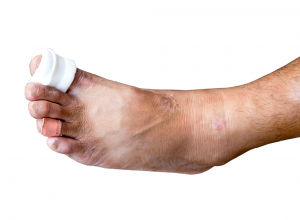
Foot and Toe Fractures
Bone fractures in the feet and toes are common, generally caused by overuse and sports activities. Though painful, this type of fracture is rarely immobilizing.
Types and Causes of Foot Fractures
Over one forth of the bones in your body are located in your feet, and fractures in the forefoot (metarsals) and toes (phalanges) happen frequently. However, the two types of bones don’t often break in the same way.
- Stress fractures: Stress fractures are small hairline cracks in a bone, and this type of fracture is common in the metatarsals, which extend from your toes to the middle of your foot. Stress fractures in the foot are often caused by repetitive stress, overuse, a sudden increase in physical activity and improper training techniques.
- Traumatic or acute fractures: Traumatic fractures are usually caused by direct blunt impact, like stubbing your toe, dropping a heavy item on your foot or falling in a way that twists the foot in an unnatural position (which can also cause sprains). Fractures that cause the ends of the broken bone to become misaligned are called displaced fractures, and fractures that break the bone but leave it aligned are called stable or non-displaced fractures.
- Jones fracture: A Jones fracture is a break that occurs in the base of the fifth metatarsal bone (behind the little toe). Many physicians accidently diagnose Jones fractures as ankle sprains, which can lead to serious complications. Therefore, it’s always best to visit qualified surgeons when dealing with pain in the fifth metatarsal bone.
- Open fractures: Open fractures are characterized by parts of the broken bone piercing through the skin. These types of fractures require immediate medical care.
Symptoms
As we mentioned above, fractures that occur in the metatarsal bones and phalanges of the foot are rarely immobilizing. However, they can be quite painful and therefore can cause significant changes in your gait (your manner of walking), which can then lead to other problems like corns and calluses.
Other symptoms of foot and toe fractures include swelling, stiffness, bruising, extreme tenderness, discoloration of the injured area and a crooked or abnormal appearance of the toe(s) or foot.
Sometimes a person might experience an open fracture (when the bone pierces the skin), bleeding, a blue or gray appearance in the injured area and/or a cold, numb or tingling sensation. All of these are signs that you should seem immediate medical attention.
Treatment
Many people believe that doctors can’t do anything for broken bones in the foot, but that is a dangerous misconception. While many foot and toe fractures can heal on their own without operative treatment, you should seek podiatric advise if you experience pain, swelling and bruising from what you think may be a broken bone. If you do not seek treatment, you could run the risk of developing:
- Chronic foot pain
- Arthritis
- A deformity in the bone that may limit movement
- A nonunion or malunion fracture (meaning the fracture is unable to heal), which can lead to major surgery and chronic pain
While you wait for your doctor’s appointment, keep weight off of the affected foot and help reduce pain and swelling by icing the area. Always use a towel so the ice does not come into direct contact with your skin.
Most surgeons will advise you to stay immobilized and avoid walking and weight bearing activities for a period of three to four weeks while the fracture heals, which it should do completely after six to eight weeks. He or she may also recommend a toe splint, buddy tape, brace, short-leg walking cast, special shoes or orthotics that will help the broken bone heal properly.
Notice concerning medical entries:
Articles having medical content shall serve exclusively for the purpose of general information. Such articles are not suitable for any (self-) diagnosis and treatment of individual illnesses and medical indications. In particular, they cannot substitute for the examination, advice, or treatment by a licensed physician or pharmacist. No replies to any individual questions shall be effected through the articles.






